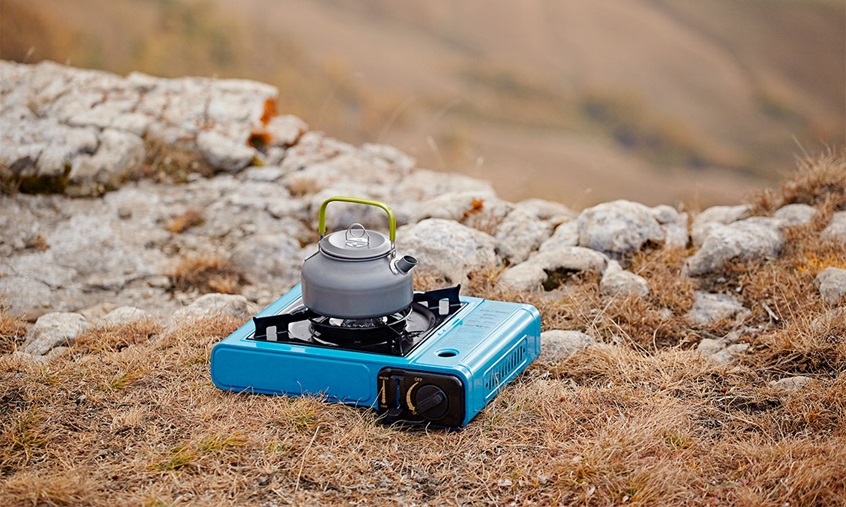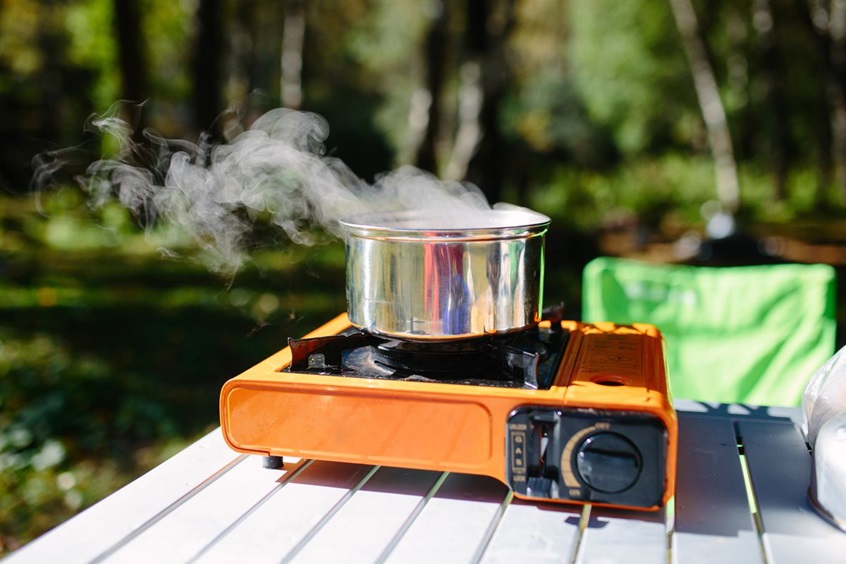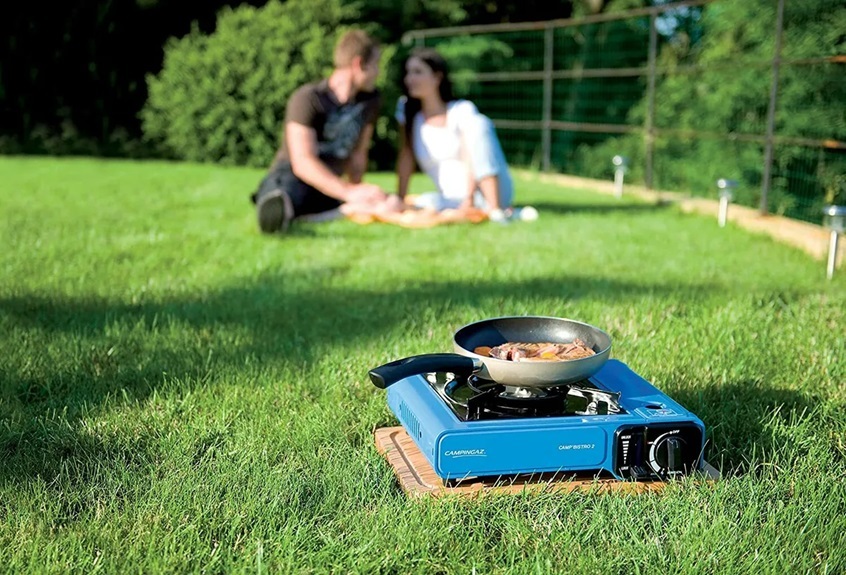
Off-the-Grid Gourmet: 6 Essential Items for Cooking in the Wilderness
Cooking under the open skies while camping holds a unique charm. The simple act of preparing a meal outdoors as the sun sets, or the stars twinkle above, adds a special touch to the experience. The crackling of the campfire, the smell of food sizzling on the grill, and the fresh air create a rustic yet satisfying ambience. But, to truly enjoy cooking in the wilderness, having the right equipment is essential. However, planning for these necessities can sometimes be a hassle. To streamline your preparation and ensure a seamless off-the-grid cooking adventure, here’s a comprehensive list of everything you might need for a delicious meal:
Contents
1. Portable Cooking Equipment

The number one tool essential for off-grid cooking is portable cooking equipment, and, among the various options, portable gas stoves are versatile and efficient choices. Their convenience and reliability make them ideal for remote culinary adventures. They provide instant heat, allowing you to cook meals swiftly and precisely in various outdoor settings. Plus, their compact design makes them easy to transport, fitting snugly in camping gear, and they’re generally lightweight, making them ideal for hiking or backpacking trips.
To set up a gas stove, you’ll need the stove itself, a compatible fuel source such as propane or butane canisters, and sometimes a lighter or match for ignition. The fuel canisters are compact and can be carried along with your camping gear. Most portable gas stoves come with adjustable flame controls, offering flexibility in regulating heat for different cooking needs. Their simple operation—ignition, flame control, and stability—makes them user-friendly even for beginners.
To maximise the use of a portable gas stove, it’s crucial to carry spare gas canisters for an uninterrupted fuel supply. Additionally, a set of durable cookware—a pot, pan, or kettle suitable for the stove’s size—is essential. Utensils like heat-resistant spatulas and tongs, along with long-lasting camping plates and utensils, complete the setup.
However, using portable gas stoves requires caution. That said, you need to ensure proper ventilation in cooking areas such as tents or canopies to prevent gas buildup. Also, make sure to place the gas stove on a stable, flat surface to minimise spillage risks. Regularly checking for gas leaks and correctly connecting gas canisters are vital safety precautions as well. It’s also important to clean the stove thoroughly after each trip to ensure longevity and optimal performance.
Understanding the stove’s functions and adhering to manufacturer guidelines are crucial steps. Prioritising fire safety protocols, including keeping a fire extinguisher or fire-suppression tools nearby, is essential for emergencies.
2. Cookware and Tableware
When cooking under open skies, essential cookware and tableware streamline your outdoor culinary experience. Opt for lightweight, durable items like titanium or aluminium camping cookware sets, featuring pots, pans, and nesting cups. Utensils like tongs, spatulas, and a sharp knife prove indispensable. Make sure you bring collapsible silicone bowls and cups to save space.
For tableware, durable, non-breakable options like stainless steel or enamel plates and mugs are vital. Embrace eco-friendly, reusable plates, bowls, and utensils for minimal environmental impact. Don’t forget insulated cups and mugs as they can keep your beverages warm or cold for extended periods. Prioritise quality over quantity, ensuring you and your camping companions enjoy the simplicity and convenience of well-chosen cookware and tableware.
3. Food and Ingredients
To prepare tasty meals outdoors, consider the following food items and ingredients:
Versatile proteins: canned beans, tuna, or dried sausage for hearty meal bases.
Non-perishable staples: rice, pasta, and quinoa offer flexible meal options.
Essential spices: salt, pepper, cumin, and chilli powder for flavour enhancement.
Fresh produce: onions, garlic, bell peppers, and durable vegetables add taste and nutrients.
Shelf-stable sauces and condiments: olive oil, soy sauce, and hot sauce for extra flavour.
You should also think about including pre-prepared ingredients that can simplify your cooking. Bring pre-cut veggies, marinated meats, or pre-mixed spices. Having fresh produce preservation, pre-prepared elements, and flavour-enhancing seasonings is key for crafting tasty meals while cooking outdoors.
4. Food Storage and Preparation

Food storage options like coolers or food containers are vital to ensure your perishables remain fresh and protected from wildlife. Also, make sure to equip yourself with a portable, easy-to-clean cutting board and a sharp knife, crucial for efficient and safe food preparation amidst nature’s setting. These tools not only preserve food freshness but also facilitate hassle-free meal preparation, optimising your outdoor culinary experience for convenience and safety during adventures in the wild.
5. Cleaning Supplies
Cleaning supplies are often overlooked, but vital tools for maintaining nature’s integrity. Remember to bring eco-friendly soaps for dishwashing, reusable cloths, and sponges to minimise waste. Consider biodegradable trash bags for responsible waste management, leaving no trace behind. Additionally, pack hand sanitisers and disinfectants for personal hygiene. These essentials ensure a clean campsite, and also help you respect and preserve the natural environment.
6. Safety Essentials
For safe outdoor cooking, make sure you have essential safety tools: pack a comprehensive first aid kit with bandages, antiseptic wipes, and medications for emergencies. Bring a fire extinguisher for outdoor use to manage unexpected flames. Carry water purification methods for safe drinking water, and a versatile multi-tool for various tasks.
Always have a reliable torchlight for visibility and emergency communication devices for connectivity in remote areas. Prioritise these safety essentials to mitigate risks and ensure preparedness during your outdoor cooking adventures. Keeping these measures in mind contributes to a secure experience, allowing you to enjoy nature’s flavours without compromising your well-being in the wilderness.
What Meals to Make When Camping?
When camping, meal planning becomes an art of simplicity and convenience. Opt for one-pot wonders like hearty stews or pasta dishes to minimise cleanup and simplify cooking. Preparing ingredients beforehand and favouring grill-friendly options, such as marinated meats or foil-wrapped veggies, streamlines cooking. Keep breakfast simple with oatmeal or pre-made pancake mix.
Snacks like vegemite sandwiches, salads, and fruits offer quick, no-fuss bites. Embrace classic campfire meals like hot dogs while exploring no-cook options such as salads or wraps. Don’t forget about campfire treats! S’mores, roasted marshmallows, or even simple desserts like bananas filled with chocolate are camping favourites.

